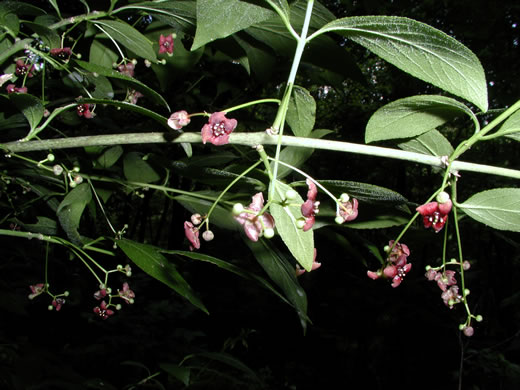Polk County’s Most Wanted – Wahoo
You hoo, have you seen wahoo?
In a joint effort to expand the knowledge and understanding of the flora and fauna of Polk County, Conserving Carolina and botanist David Campbell need your help in locating this month’s “Polk County’s Most Wanted—Plant,” one of NC’s more rare shrubs, Eastern Wahoo (sometimes referred to as Burning Bush), Euonymus atropurpureus.
Wahoo (Euonymus atropurpureus), our native Burning Bush, should not to be confused with the non-native and invasive ornamental shrub, Winged Burning Bush (Euonymus alatus) which is native to Northeast Asia and fairly common in residential areas. Wahoo is only known from a handful of counties in NC and it is ranked as “imperiled.” It is a large shrub or small tree, which is typically found in areas to the east of Polk County. Wahoo is not a ‘stand out’ species in terms of general appearance. It has simple, opposite, and finely toothed leaves with erect-hairy lower leaf surfaces and petioles (the stalk that attaches the leaf blade to the stem).

One unusual feature of this species is the green coloration of the twigs, which persist even in winter. The fruits of Wahoo are bright pink and red, which enables them to be seen easily from a distance; a good clue when searching for the plant this time of year. The fruit is a smooth, 4-lobed capsule. Wahoo’s preferred habitats are rich bottomlands or streamside flats. Occasionally, this species may be encountered on rich slopes with circumneutral soils.
There have been recent reports of this beautiful and seldom-seen species from the eastern portions of Polk County. Be on the lookout for the colorful fruits of this species in the next 4-6 weeks. The fruits will be growing on a large shrub in low woods that contain small streams or creeks. If you think that you have seen Eastern Wahoo in Polk County, please send photos, questions, or comments to Pam Torlina at Conserving Carolina by phone at (828)697-5777, ext. 300 or email, [email protected], so we can document its occurrence in Polk County. Also, don’t forget to look for other Polk County’s Most Wanted plants that may be blooming at this time of year, such as Pink Thoroughwort (Fleischmannia incarnata), Small-headed Blazing-star (Liatris microcephala), Largeleaf Grass of Parnassus (Parnassia grandifolia), Poison Sumac (Toxicodendron vernix), Yellow Giant-hyssop (Agastache nepetoides), and others.
See more information about “Polk County’s Most Wanted” and download and print a Pocket Guide with all of the “most wanted” plants, animals, and habitats that you can be on the lookout for when you’re out in the field!
